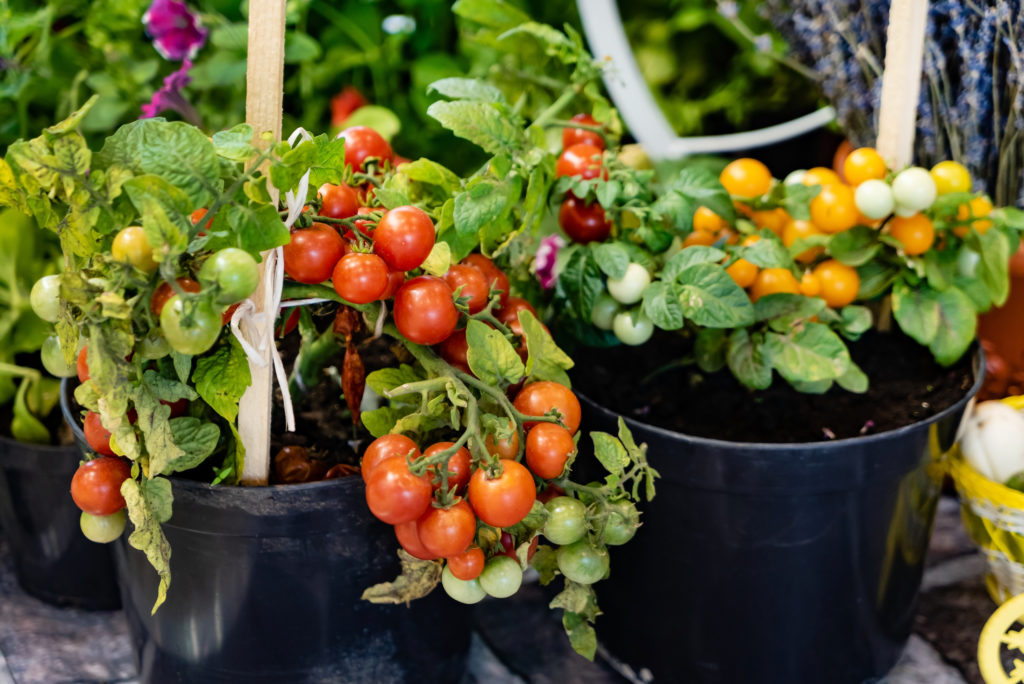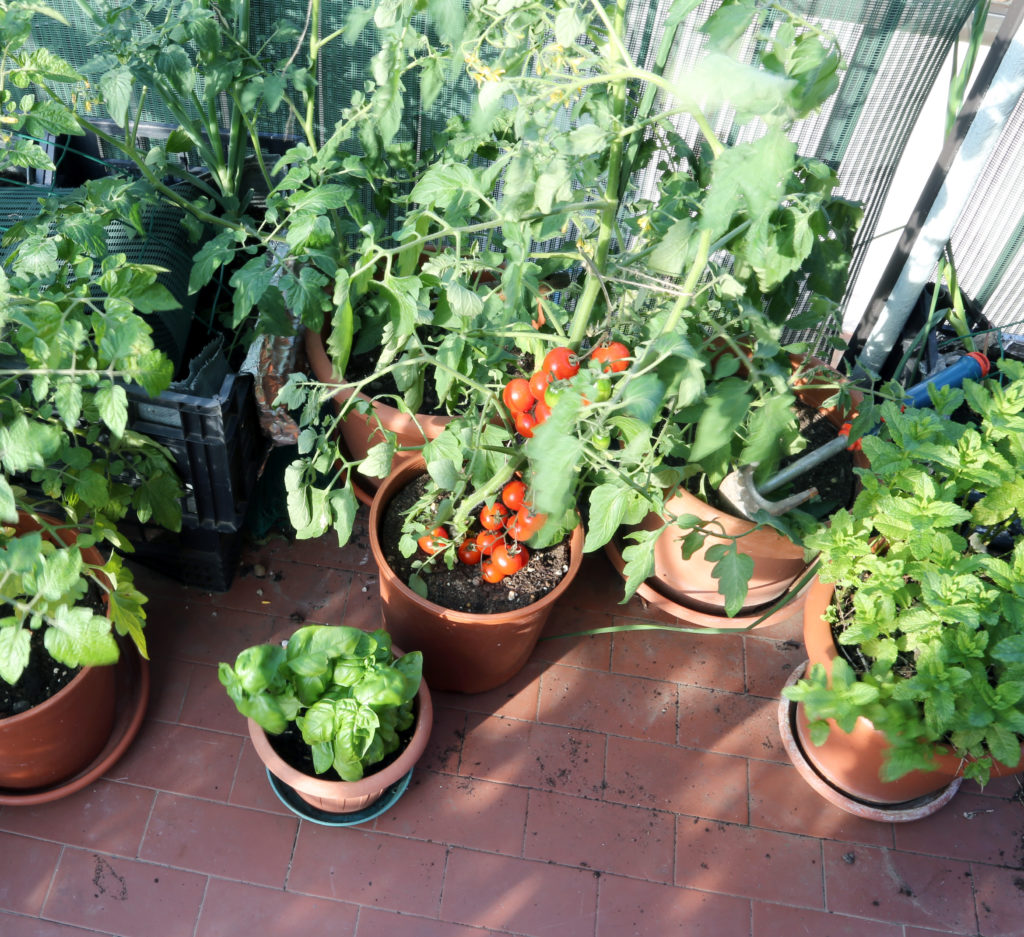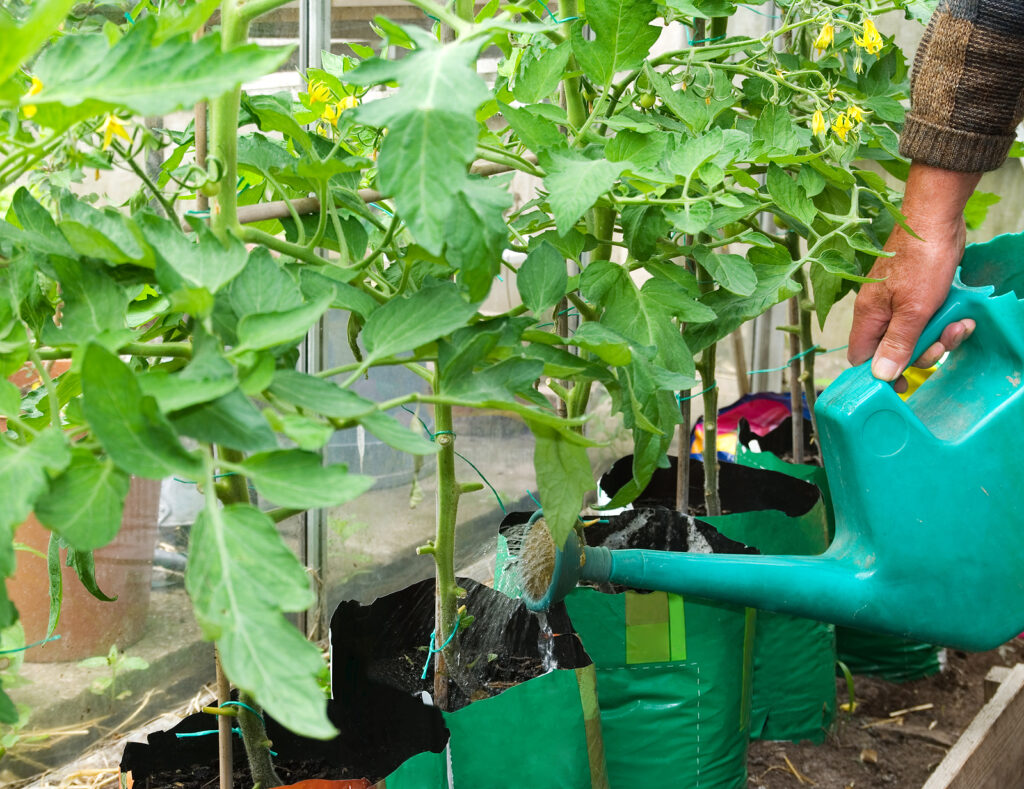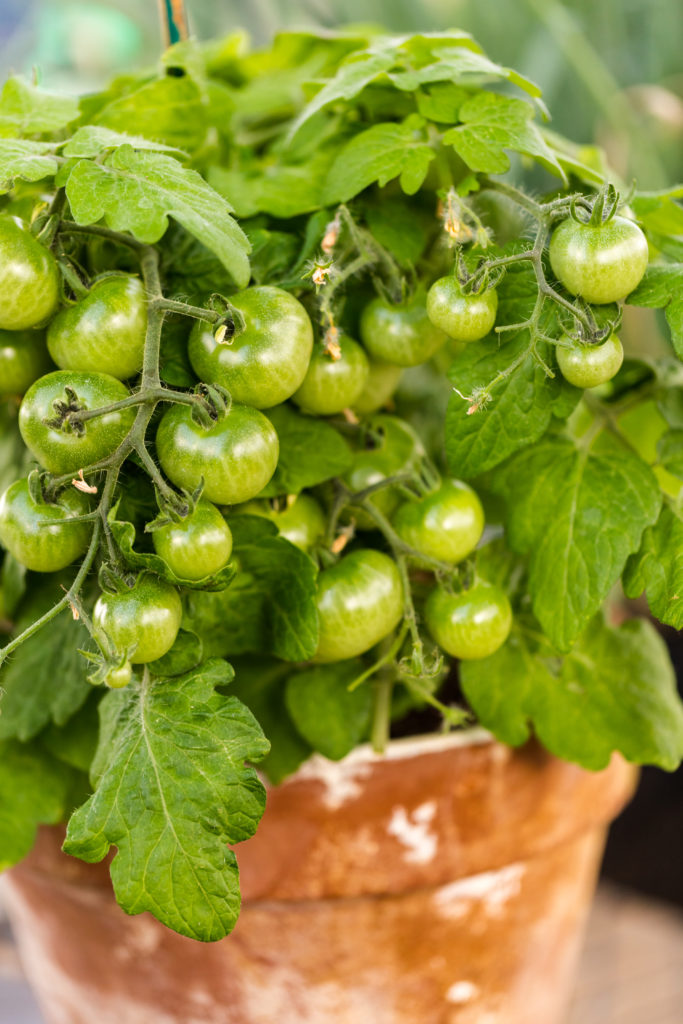Tomatoes are easily grown in containers—clay pots, plastic nursery pots, and wood boxes
Container-grown tomatoes have the same growing requirements as garden-grown tomatoes: 6 to 8 hours of sunlight each day, nutrient-rich soil, and enough water or soil moisture for steady, even growth.
Best tips on How to Plant, Grow, and Harvest Tomatoes.
You can grow any type of tomato in a container—a miniature currant-sized or small cherry tomato or a tall, vining beefsteak tomato—as long as the container is large enough to hold enough soil to keep the plant upright and support the plant’s nutrient and water needs.

Best tomatoes to grow in containers
Small tomato plants that deliver a big flavor are just right for growing in small gardens and on decks, patios, and balconies.
Small tomato plants range in size from 18 inches tall or less to no more than 3 or 4 feet tall. Small tomatoes require no staking or caging—but you can.
Fruits on small tomato plants can range from cherry-size to as large as one pound, about the same size as many large vining plants.
The flavor from small plant fruits can vary just as with larger plants from mild, to acid-sweet, to a full old-fashioned tomato taste.
10 flavorful tomatoes for container growing
You should be able to find seedlings for one or more of these small tomatoes at a nearby garden center. All are readily available from seed growers online or in garden centers.
- Better Bush: small, compact bush for patio, deck, or balcony containers; fruits to 8 ounces, with old-fashioned tomato flavor; to from 3 to 4 feet tall; requires staking. Indeterminate, hybrid VFN, 68 days to harvest.
- Bush Beefsteak: a compact plant with good-sized beefsteak-shaped fruit, 6 to 8 ounces. Determinate, open-pollinated, 62 days to harvest.
- Bush Early Girl: small, compact plants with a top yield of 6- to 7-ounce fruits and very good flavor. Determinate, hybrid VFFNT, 54 days to harvest.
- Clear Pink Early: a compact plant with trusses of round, smooth pink fruit; sweet and tangy flavor. Russian heirloom, determinate, open-pollinated, 58 days to harvest.
- Early Wonder: compact plant produces round, dark pink fruit to 6 ounces; full tomato flavor, great taste. Determinate, open-pollinated, 55 days to harvest.
- New Big Dwarf: compact to 2 feet tall; flavorful fruits from 8 ounces to 1 pound. “New” from 1915, so this is an heirloom; determinate, open-pollinated, 60 days to harvest.
- Red Rocket: compact, bush with smooth, flavorful, even sugar-acid blend fruits, 8 to 10 ounces. Determinate, open-pollinated, 60 days to harvest.
- Tiny Tim: small plant for containers growing to about 18 inches tall; use a 6-inch pot; bright red cherry tomatoes to about ¾ inches. Determinate, open-pollinated, 60 days to harvest.
- Tumbling Tom: small plant for hanging baskets, cascading habit to about 18 inches; 1- to 1-inch cherry tomatoes; can grow in a 6-inch pot. Determinate, hybrid, 70 days to harvest.
- 506 Bush: small plant to 18 inches tall with medium size, mild-flavored, bright red fruit with a hint of sweetness; good drought tolerance. Determinate, open-pollinated, 62 days to harvest.

Containers for tomato growing
Simply, the container to grow a tomato should be big enough to hold the plant, which means large enough to contain the soil necessary to deliver nutrients and water for plant growth, and large enough that the plant at maturity does not tip the container.
There are miniature tomato varieties that will grow in an 8-inch pot—roughly the size of a one-gallon container. A 2-gallon or a 5-gallon container can support larger, indeterminate, or vining tomatoes and hold enough soil moisture for three or more days when the weather turns hot in summer. A 5-gallon nursery pot is roughly the size of a 2-by-2-foot redwood box; a 2-gallon container is the size of a 10-inch pot.
Be sure the container has large drainage holes in the bottom. Set the container up off of the patio, deck, or balcony with pot feet or on wood strips; this will allow for adequate drainage and ensure plant roots do not bake on hot days when cement or wooden decking gets hot.
If you are growing tomatoes in a window box planter or hanging container make sure the container is securely fastened and has drainage holes.
Soil for tomato containers
The soil for growing tomatoes in containers should be nutrient-rich and moisture-retentive but well-draining. Use a commercial potting mix or mix your own potting soil.
Here are some quick do-it-yourself potting mixes:
· Compost mix: mix 3 parts (such as a gallon) of garden soil, 3 parts of compost, and 2 parts of builder’s sand.
· Soil mix: 4 parts garden soil (be sure the garden soil is free of stones and debris and disease-free), 1½ parts sphagnum moss, 1½ parts builder’s sand, 1 part aged, dried steer manure.
· Soilless fertilized mix: 1 part horticultural grade vermiculite and 1 part aged compost, add a half spoonful or so of ground dolomite limestone, a half spoonful of superphosphate, and a half spoonful 5-10-5 fertilizer; mix thoroughly. This is a good mix for hanging baskets or window boxes.
Fill the container to about 2 inches below the rim allowing enough room for watering.

Small tomato growing tips
- Like large tomato plants, compact tomatoes require 6 to 8 hours of sunlight each day—especially if you are growing for optimal flavor.
- Also like large tomato plants, compact tomatoes require consistent moisture for steady, even growth and maximum flavor. Keep the soil in your containers evenly moist—meaning do not let it dry out or get soggy.
- Feed container growing tomatoes every three weeks with a water-soluble fertilizer high in phosphorus, 5-10-5 is about right.
- A 2-gallon, 8- to 10-inch pot or box is right for most small tomato plants; some can grow in pots as small as 6 inches across, about the size of a 1-gallon nursery container.
Planting and staking tomatoes in containers
Plant tomatoes in containers just as you would set transplants in the garden. Pinch off the lower leaves of seedlings and set them vertically in the pots or hanging planters as deep as you can.
Most miniature and dwarf varieties will not need staking, but if you are growing a vining, indeterminate variety, it will require a stake or cage just as it would in the garden. Large, vining tomatoes are likely to grow rapidly and fruit heavily, so be prepared to prune or pinch away leaves and fruit that could cause the container to tip.

Watering tomatoes in containers
Tomatoes growing in containers, like tomatoes growing in the garden, need a continuous, uninterrupted supply of moisture. Do not let the soil in a container go dry and conversely do not allow the soil to be overly wet or soggy
The smaller the container the more frequently you will need to water it. Keep in mind that frequent watering will likely leach nutrients through the soil mix in the containers. Add a water-soluble fertilizer to your watering can every three weeks or so or renew nutrients that are leached from the soil.
Water whenever the soil becomes dry down to about a half-inch or slightly more below the soil surface; this might mean watering once a week in mild weather or watering up to three times a week in hot, dry weather. When a plant growing in a container begins to wilt towards the end of the day it is time to water; if you find a plant wilted in the morning, it has gone too long without water and needs immediate attention.
When you water, be certain that the water reaches the soil at the bottom of the container. Water the container thoroughly, until the water runs out of the drainage hole at the bottom, or put water in a saucer or tray under the container and allow the soil to wick water up from the saucer into the container. A container should draw all the water it needs from a bottom tray in about 30 minutes. Do not let the container sit in a saucer of water longer than 30 minutes; root rot can be caused by overly wet soil.
You can place a perforated drain pipe in the container—from the soil line to the bottom of the container, fill it with builder’s sand and pour water into the pipe; that way you can be certain water reaches the bottom of the container and all of the soil in between.
Avoid watering late in the evening or watering plant leaves; this encourages disease.
Feeding tomatoes in containers
Commercial potting mixes contain enough nutrients to sustain containerized tomatoes for about six weeks; after that use add a water-soluble fertilizer to a gallon watering can and feed tomatoes in containers about every two or three weeks. Use a fertilizer high in phosphorus to support fruit growth; a 5-10-5 fertilizer will deliver sufficient nutrients to a heavy-cropping tomato. Follow label instructions, commonly 1 tablespoon of water-soluble fertilizer per gallon of water, feeding every three weeks.
Sunlight for tomatoes in containers
Container-grown tomatoes—like tomatoes in the garden– should receive maximum sunlight, 8 hours– 4 hours in the morning and 4 hours in the afternoon—is optimal. If you are growing on a balcony, turn the container at least once a week so that the plant develops symmetrically. If your containers are too heavy or bulky to turn by hand, set them on wheels or plant dollies so that they are easily rotated and moved.
Tomato pollination
Tomatoes have complete flowers—meaning the male and female parts are in the same flower. Wind and insects aid tomatoes in pollination. If your container-grown plants are sheltered from light breezes or off the beaten path of bees and other insects—growing high on balconies, you can aid pollination and fruiting by gently shaking the plants once a day to ensure pollination.
Caring for tomatoes in containers
Container-grown tomato plants are subject to the same diseases, insects, and disorders as plants grown in gardens. Keep an eye out for weeds and watch for pests and diseases.
If you are growing small tomatoes in hanging baskets and want to train your plants to cascade—making harvest easier, tie 1-ounce fishing weights to the end of branches early on to train them to grow over the edges of your hanging pots.
Also of interest:
Tomato articles at Harvest to Table:
How to Plant and Grow Tomatoes
How to Choose a Tomato for Your Garden
Growing Tomatoes in Containers
Growing Early Season Tomatoes for Great Taste
Epsom Salt, Milk, and Organic Fertilizers for Tomatoes and Peppers
How to Prevent Blossom Drop – Tomatoes and Peppers
How to Harvest and Store Tomatoes
Nine Ways to Cook and Serve Tomatoes
Tomato Sauce–Basic, Herbed, or Vegetables Added
How to Make Tomato Juice Simply
How to Home Can Tomatoes for Beginners
How to Sun Dry and Oven Dry Tomatoes
Tomato Growing Problems Troubleshooting
How to Prevent Tomato Blossom Drop
How to Identify Early Blight, Late Blight, and Leaf Spot
Tomato Hornworm Organic Pest Control
Garden Planning Books at Amazon:
- Tomato Grower’s Answer Book
- Vegetable Garden Almanac & Planner
- Kitchen Garden Grower’s Guide Vegetable Encyclopedia
- Vegetable Garden Grower’s Guide




